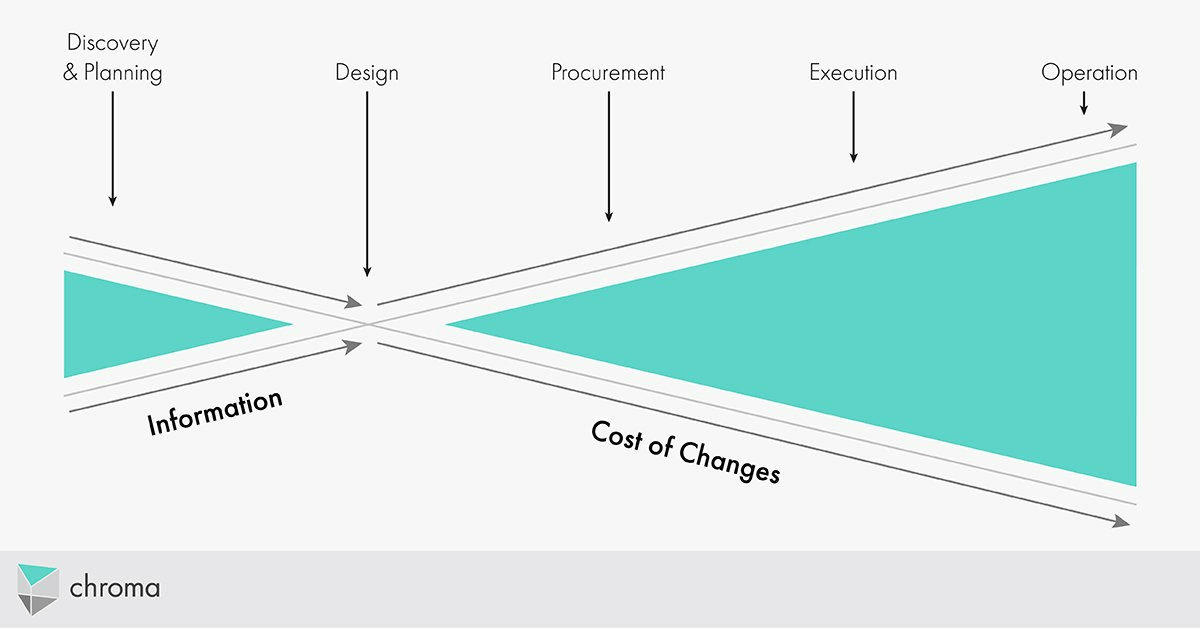What’s the best way to start an AV project? Should you go directly to an installation contractor? Or is it best to seek help from a design consultant?
At first glance, it may seem cheaper to go to a contractor. Designers tend to cost more due to their upfront design fees. And when an AV contractor offers a complete system without the added cost of design, you may wonder why you should bother with an expensive consultant. Is all this design process really necessary?
To answer this question, consider the project’s total cost of ownership (TCO):
A breakdown of a construction project’s Total Cost of Ownership
Design engineering represents only 1-2% of the TCO. And as we’ll explain in this article, spending a few more dollars on design upfront will save you money at every other stage of the building’s life cycle.
Here’s how:
Refine Your AV Solution At Minimal Cost
It’s easy to make changes on paper. At this point in the process, we are working with construction drawings and infrastructure that has yet to be installed. You can add extra speakers to a lobby for ambience, move a control panel for better access, or swap out a wall-mounted display for a retractable screen. We will update the drawings with these changes before the job is quoted and equipment procured.
From a cost-savings perspective, it’s critical that these adjustments are made before the installation begins. Changing user-facing equipment often creates a whiplash effect back through the cable and AV rack infrastructure requirements. During the design stage, the need for more amp channels or control lines can be addressed upfront and factored into the design package. In contrast, it’s expensive and burdensome to physically change or add infrastructure once construction has begun.
This is why an established process is so critical. A consultant’s AV design services are the linchpin of a successful installation that satisfies operational needs and lowers the total cost of ownership. Insights from the discovery and planning stage are filtered into a detailed design package that includes the AV system specification and a comprehensive drawing set. Once reviewed and approved, the design can be integrated into the overall construction plans and sent out to tender.
The design stage is the most cost-efficient time to make changes
Simply put, a thorough design process sets your project up for success. It is the ideal time to solve problems and refine the AV system. The time and money required to make adjustments will only grow from this point onward, as we’ll explore below.
Enjoy Hassle-Free System Procurement
With an airtight bid package in hand, the procurement process becomes a breeze. You won’t need to deal with countless questions about who is responsible for each component because the scope boundaries will be crystal-clear.
When AV system specifications are unclear, bidders tend to pad their proposals so they aren’t left uncompensated for something that falls into their lap. This uncertainty eats away at time and money for all involved. In addition to flooding inboxes with requests for clarification, there may be disagreements down the track about who should pay for something that nobody felt was in their scope.
Conversely, with a thorough system design, anything required of the general contractor or electrical contractor will be well-defined and a surprise to no one. This may include plywood backing for display mounts, electrical boxes for control panels, or bonding cable for the AV equipment racks. The party responsible for each of these items may vary from job to job, so it’s important to clarify requirements early.
When your design package is clear and complete, bidders will be enthusiastic about participating. You will see more competitive offers as they bring their best proposals—and sharpest prices.
Mitigate Construction Delays And Expenses
Have you ever tried to assemble a piece of Ikea furniture without instructions? Even if you end up with a functional bookshelf, think of all the time that is wasted making and correcting assumptions about how things fit together. Further, think of the wear and tear on every piece of particleboard as they’re repeatedly screwed together, unscrewed, and shuffled around. This is what happens to your building when one of your trades doesn’t have clear instructions.
When it comes to AV integrations, some things are intuitive, but some aren’t—even to the experts. And since the bulk of an AV installation happens during the finishing phase of construction, wear and tear from changes and repetition is not always hidden.
For example, a late-stage design change might dictate new ceiling speaker locations. So now, the AV installer has to re-cut speaker holes in a freshly painted ceiling when they’d rather be testing and commissioning. Further, the drywallers and painters have to patch previously completed work, putting the GC behind schedule and forcing the coordinator to decide who will eat the cost. It’s not anyone’s idea of a good time.
With a detailed AV design and regular consultant field reviews, small problems stay small. The design also anchors the AV commissioning process, an AV consultant's final stamp of approval that confirms you got what you paid for.
By this point, any tweaks to the system may involve redoing work—to the potential detriment of adjacent finishes and infrastructure. So you can see how changes become more costly as we move along. However, even during construction, they are not nearly as expensive as they will be once the building opens and all the trades leave site.
Realize Your AV System’s Full Potential
It’s after the system is built that the true value of thorough design engineering is revealed. And while some benefits may seem less tangible than construction costs, the very real expense of blocking off an area for work quickly becomes clear if further adjustments are required—particularly if a wall or ceiling needs to be opened for access.
And, believe it or not, the intangible expense of not correcting the system far outweighs the cost of renovation. AV systems are designed to serve a purpose: to support the organization’s work. Commercial AV is not just icing on the cake of an otherwise effective building. It increases profit by creating operational efficiencies, new revenue opportunities, or both.
Further, consider the building occupants’ safety and security. Mass notification and emergency messaging systems require building-wide override capabilities to be effective, and changes can disrupt their operation.
Suppose well-intentioned adjustments are made post-occupancy, for example, by changing speaker or display layouts to improve the working environment and foster creativity. Will you have an opportunity to re-test the emergency systems? Will it be expensive to create that opportunity? And what risks do you expose your organization to if you don’t? These situations will arise less frequently—if at all—after a detailed design process that incorporates the views of multiple stakeholders.
If an AV system allows your people to do their best work every day, it creates immense value for your business. And if it enhances what you can deliver to your customers—whether via slick presentation capabilities, superior ambiance, or a host of the other benefits provided by modern audiovisual technology—it could give your company a competitive advantage.
At Chroma, we design AV systems that are useful and usable. Because if the system doesn’t meet users’ needs, what’s the point? User frustration has a high human resource cost, and AV technology should be an enabler of productivity, not a barrier.
Further, our systems are durable. Excessive repairs eat up operations budgets, and short equipment lifecycles are a pain. We use our knowledge of current technology and industry trends to specify systems that will endure reliably for years to come.
Finally, our systems are scalable and expandable. By making small provisions during design, we allow for future flexibility as needs change. These provisions may include extra cabling, excess network or channel capacity, or identifying standards-based technologies that will interface with future equipment.
AV design is a worthwhile expense that will benefit your project before, during, and after construction. Contact us today to learn more about our AV design services.



